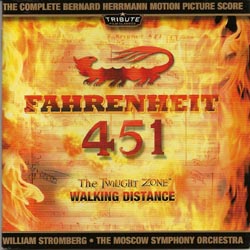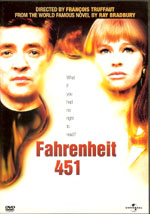 20th Annual Sammy Film Music Awards
20th Annual Sammy Film Music Awards 
Preservation Award - Best Restored Film Score
 Editor's Choice: Editor's Choice:
Best of the Month
December 2007
|

FAHRENHEIT 451 (1966)
and WALKING DISTANCE (1959)
Music composed by Bernard Herrmann.
The Moscow Symphony Orchestra, conducted by William Stromberg.
55 Tracks (Playing Time = 77:40)
Executive Producer: Anna Bonn. Album produced by Anna Bonn, John Morgan and William Stromberg. Recording Engineer: Alexander Volkov. Recorded at Mosfilm Studio,Moscow, Russia, April 2007. Cover Art: Robert Stromberg, Charles Johnston. Design: Charles Johnson. CD notes: John Morgan, Ray Bradbury, Gunther Kogebehn, Christopher Young, William Stromberg, Anna Bonn. Track Notes by Kevin Scott.
Tribute Film Classics TFC-1002
Rating: ****
From the first time I watched this film when it was first released in 1966, I have marveled at the evocative score full of magical orchestral sounds. Though I would not agree with John Morgan's statement in the CD booklet that this is Bernard Herrmann's "last great masterpiece," I would say it is surely one of the greatest futuristic film scores of them all.
Unlike fantasy films with Ray Harryhausen stop-motion effects such as MYSTERIOUS ISLAND and JASON AND THE ARGONAUTS, both with terrific Herrmann scores, FAHRENHEIT 451 has more to say as a film and as a score. And this score does it with much simpler orchestral forces, just strings, harps and a few percussion instruments. There are no brass or woodwind instruments used and this is similar to Herrmann's classic score PSYCHO for Alfred Hitchcock which uses just strings for what Herrmann called a "black and white sound."
When he came to work on Francois Truffaut's treatment of the Ray Bradbury novel, FAHRENHEIT 451, and Herrmann read the novel and said:
"I felt that that the music of the next century would revert to a great lyrical simplicity and it wouldn't have truck with all this mechanistic stuff. Their lives would be scrutinized. In their music they would want something of simple nudity, of great elegance and simplicity."
--quoted in Kevin Scott's CD notes from Steven C. Smith's Herrmann biography, A Heart at Fire's Center.
This Tribute Film Classics CD release is an excellent companion soundtrack to their other initial release MYSTERIOUS ISLAND, which employs a huge orchestra and is full of dynamic bursts of sound. But FAHRENHEIT451 is a much quieter and more restrained score.
 Herrmann made a recording of the suite from FAHRENHEIT 451 in 1974 with about 10 minutes of music. It has been re-issued on a London CD [cover shown at left]. The suite consisted of these cues: Prelude/ Fire engine/ The bedroom/ Flowers of fire/ The road and finale.
Herrmann made a recording of the suite from FAHRENHEIT 451 in 1974 with about 10 minutes of music. It has been re-issued on a London CD [cover shown at left]. The suite consisted of these cues: Prelude/ Fire engine/ The bedroom/ Flowers of fire/ The road and finale.
While the Phase 4 Stereo was quite good for its time, the Film Tribute Classics CD far exceeds it in its sound quality and completeness of the score.
On the TFC CD, the opening brief Prelude (1:34) beautifully accompanies the unique opening of the film which features the credits spoken instead of being shown on the screen. This is done since the story concerns the banning of books which are illegal to be read. Following that quiet opening is the incredibly rhythmic and barbaric sounding "Fire Station" (0:53), a theme for the cold and mechanical firemen who are responsible for setting fires to books not putting out the fires. This rhythmic theme will reappear on a number of occasions, such as the incredibly dynamic "Fire Alarm" (track 22, 1:40) featuring xylophone and harps along with the strident strings. But much of this score is on the more subtle side.
One example of the quieter music is "Clarisse" (track 4, 1:06), who is Montag's neighbor and later his comrade in helping to save the books for the future generations. There are many other examples one could mention but suffice it to say that they all add to the suspense and message from Bradbury's great novel, so well made by Truffaut, and who considered Herrmann's score an important part of his film.
There are 47 cues for the complete FAHRENHEIT soundtrack and 12 of them have music cut from the film. There are also two entire cues (tracks 15 and 19) that were cut entirely from the film. Though the CD is arranged with a series of short cues, most lasting less than two minutes, it all fits together beautifully with each cue flowing along as if part of longer cues.

The final tracks (track 45: The Road/ track 46: First Snows of Winter/ track 47: Finale) are among the most poignant of any themes composed by Herrmann. Ray Bradbury said on the DVD bonus features about the music of FAHRENHEIT 451 that he couldn't watch the end of this Truffaut film without crying, thanks largely to Bernard Herrmann's extremely melancholy and moving music. Many who love this film, including me, would agree with Ray Bradbury's statement.
DVD: FAHRENHEIT 451
(includes excellent bonus feature on
"The Music of Fahrenheit 451")
In addition to the complete FAHRENHEIT 451 score there is the added treat of music from an episode of Rod Serling's classic TV series, THE TWILIGHT ZONE.
Herrmann was asked to compose several scores for this award-winning series, including one of the most famous episodes titled, "Eye Of The Beholder," which has some of the same orchestral sounds (especially harps and strings) heard in FAHRENHEIT 451.
But the one that many consider Herrmann's best score for the series is "Walking Distance" from 1959. This happens to be my favorite TZ episode as well.
It is a poetically told story written by Rod Serling concerning Martin Sloan (expertly played by Gig Young) who returns to his boyhood home. Named Homewood in the episode, it is actually based on Rod Serling's own boyhood home of Binghamton, New York -- where I also lived for a few years while in graduate school.
Bernard Herrmann seemed to feel a deep kinship with this touching story and composed one of his most heartfelt scores for this TV episode. The detailed CD notes by Kevin Scott discuss the possible influences of Herrmann's music on the minimalist composers such as John Adams and Philip Glass. Scott also rightly mentions that Herrmann had a deep admiration for English composers and in several of the cues for "Walking Distance" invoked Handel and Purcell's music. Actually Herrmann made a direct quote, first heard in "Martin's Summer" (track 53, 1:07). The quote is from Handel's L'Allegro, il Penseroso ed il Moderato (1740). The musical passage Herrmann borrowed from Handel was on these lines from John Milton's dreamlike poem:
Thus past the day,
to bed they creep,
By whisper'ring winds soon lull'd asleep.
Herrmann's quote from Handel continues on the next track, "Elegy" (track 54, 3:59), with high strings bringing out all the intensely nostalgic emotion implied in Serling's superb script.
The orchestra used by Herrmann for this TV score consisted of 6 first violins, 4 second violins, 3 violas, 3 cellos, 2 basses, and 1 harp. For the TFC CD, John Morgan and William Stromberg have expanded the orchestra into a larger string ensemble but not changed any of Herrmann's notes.
"Walking Distance" is a masterpiece of television scoring and can be performed in a concert hall without any apologies needed. I believe it is Herrmann's greatest score for television.
The Tribute Film Classics CD provides a fuller sound than heard on Herrmann's original mono score, available on a several different CD collections, including this one:
TWILIGHT ZONE -
THE 40TH ANNIVERSARY COLLECTION (4 CD box set)
"Walking Distance" (Disc One, track 17, 12:24)
There are also several single CDs released from Varese Sarabande and useful for comparison:
The Best of Rod Serling's The Twilight Zone
(includes Herrmann's original scores for "Where Is Everybody?" and "Walking Distance")
Bernard Herrmann: The Twilight Zone (re-recordings of 7 Herrmann scores for TZ episodes, conducted by Joel McNeely)
But the recorded sound of the TFC CD is far superior to any previous release of "Walking Distance." The same applies to the FAHRENHEIT 451 soundtrack. The solo instruments can be heard with up close vividness, including Herrmann's favorite combination of vibraphone and strings. This excellent sound makes for a most enjoyable listening.
As with the MYSTERIOUS ISLAND release, the 32 page booklet with the FAHRENHEIT 451 CD is a beautiful piece of work, beginning with the gorgeous cover art by Robert Stromberg and design by Charles Johnston.
Inside are appreciative comments by score restorer John Morgan, Bernard Herrmann Society's Gunther Kogebehn, composer Christopher Young (who provides an outstanding list for studying Herrmann's film scores and first got hooked on Herrmann while living in New Jersey, just like me), conductor William Stromberg, producer Anna Bonn, and excellent technical notes written by Kevin Scott.
 This Tribute Film Classics CD of FAHRENHEIT 451 and "Walking Distance" is a treasure of musical delights to enjoy over and over again.
This Tribute Film Classics CD of FAHRENHEIT 451 and "Walking Distance" is a treasure of musical delights to enjoy over and over again.
One of the best restorations of this or any year.
It is an essential CD for any Herrmann collection.
Highest recommendation.
--Roger Hall, 6 December 2007
FAHRENHEIT 451 is listed on the 100 Essential Film Scores of the 20th Century.
Comments regarding this review can be sent to:
Film Music Review
Read more about Bernard Herrmann's film music in this book--
.jpg)
A Guide to Film Music
Please Help Support
The Sammy Film Music Awards
make a donation and receive a DVD or CD
click here

Film Music Review (Home Page)
Return to top of this page
